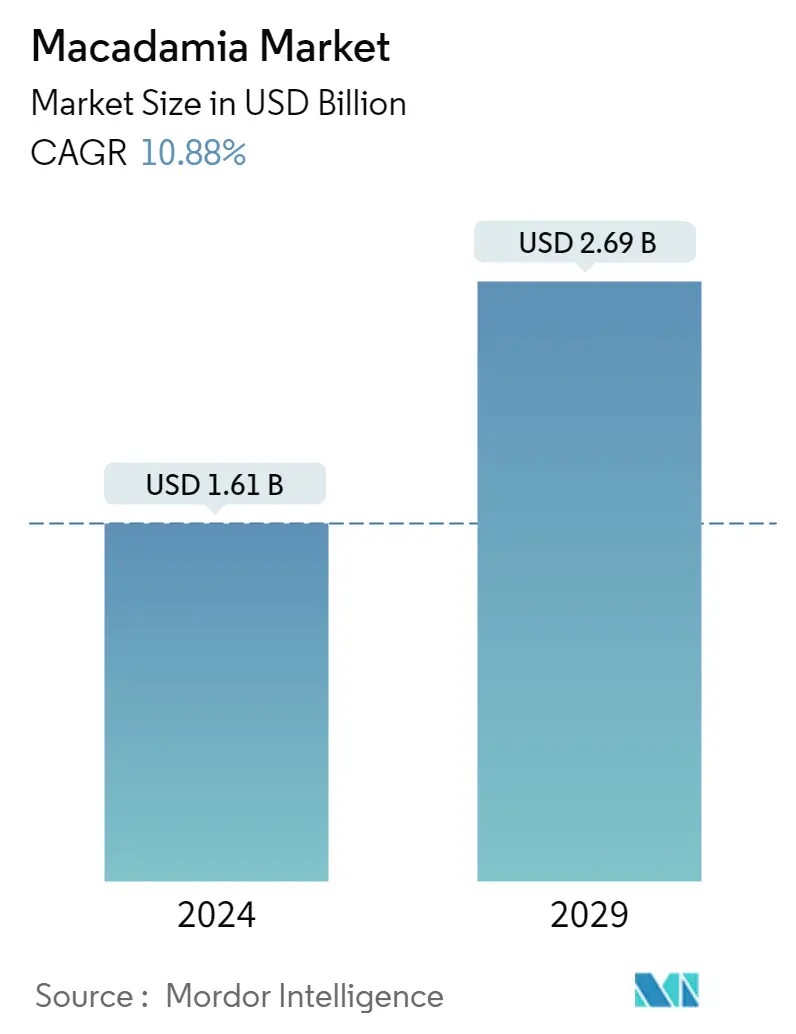Market Size of Macadamia Industry

| Study Period | 2019 - 2029 |
| Market Size (2024) | USD 1.61 Billion |
| Market Size (2029) | USD 2.69 Billion |
| CAGR (2024 - 2029) | 10.88 % |
| Fastest Growing Market | Asia-Pacific |
| Largest Market | North America |
Major Players*Disclaimer: Major Players sorted in no particular order |
Macadamia Market Analysis
The Macadamia Market size is estimated at USD 1.61 billion in 2024, and is expected to reach USD 2.69 billion by 2029, growing at a CAGR of 10.88% during the forecast period (2024-2029).
- The market is growing faster with the importance of healthy eating habits and increased demand for plant-based protein foods. For instance, according to the Government of Canada, the protein demand is expected to reach 953.5 million metric tons by 2025, which includes a 14% of annual increase in plant-based proteins. This increase in dependency is becoming a driving factor for the market. The pandemic further boosted it. Consumers are more frequently choosing nuts as a healthy snack option and incorporating them into their daily diets resulting in healthy market growth over the long term.
- Additionally, organic macadamia is gaining popularity on the consumption side, with increasing demand coming from European countries. The wide application of processed macadamia in different industrial segments, such as the food and beverage and cosmetics and personal care industries, is also augmenting the growth of these nuts in the global market.
- Moreover, South Africa, Australia, Kenya, China, and Hawaii in the United States are the largest macadamia producers in the world. As reported by the Australian Macadamia Society, favorable weather conditions, with most regions receiving good rains, resulted in sound production in 2021. In contrast, adverse conditions during flowering and early nut development, mature orchards, pruning, and insects and diseases led to declined macadamia crops in South Africa in 2021. Therefore, the increased usage and growing production of macadamia is contributing to the market's growth in the coming years.
Macadamia Industry Segmentation
Macadamia is a genus of four tree species indigenous to Australia and constituting part of the plant family Proteaceae. Macadamia nuts are native to northeastern New South Wales and central and southeastern Queensland. The Macadamia Market is segmented by geography (United States, Canada, Guatemala, Germany, Netherlands, China, Australia, Japan, Vietnam, Brazil, South Africa, and Kenya). The report includes the Production Analysis (volume), consumption analysis (value and volume), export analysis (value and volume), import analysis (value and volume), and price trend analysis. The report offers market estimation and forecast in value (USD thousand) and volume (metric ton).
| Geography - Production Analysis(Volume), Consumption Analysis (Value and Volume), Import Analysis (Value and Volume), Export Analysis (Value and Volume), and Price Trend Analysis | |
| United States | |
| Canada | |
| Guatemala | |
| Brazil | |
| Germany | |
| Netherlands | |
| China | |
| Japan | |
| Vietnam | |
| Australia | |
| South Africa | |
| Kenya |
Macadamia Market Size Summary
The macadamia nuts market is experiencing robust growth, driven by the increasing consumer shift towards healthy eating habits and the rising demand for plant-based protein foods. This trend has been further accelerated by the pandemic, as more consumers opt for nuts as a nutritious snack, integrating them into their daily diets. The market is also benefiting from the growing popularity of organic macadamia nuts, particularly in European countries. The versatility of processed macadamia nuts in various industries, such as food and beverage, cosmetics, and personal care, is contributing to their expanding presence in the global market. Major producing regions, including South Africa, Australia, Kenya, China, and Hawaii, are seeing fluctuations in production due to varying climatic conditions, which impacts the global supply chain. However, government initiatives and investments in research and development are helping to stabilize and boost production levels, ensuring a steady supply to meet the rising demand.
In Australia, macadamia nuts are a significant horticultural export, with a substantial portion of production being exported to international markets such as Japan, Korea, Taiwan, China, Europe, and North America. The Australian macadamia industry is characterized by significant investments in productivity improvements and research, which have led to increased production and export capabilities. These efforts are supported by government programs aimed at enhancing microclimate monitoring and digital data utilization, further aiding the industry's growth. The global market for macadamia nuts is expected to continue its upward trajectory, supported by changing consumer preferences for nutritious diets and the strategic investments made by growers in production and export infrastructure.
Macadamia Market Size - Table of Contents
-
1. MARKET DYNAMICS
-
1.1 Market Overview
-
1.2 Market Drivers
-
1.3 Market Restraints
-
1.4 Value Chain Analysis
-
-
2. MARKET SEGMENTATION
-
2.1 Geography - Production Analysis(Volume), Consumption Analysis (Value and Volume), Import Analysis (Value and Volume), Export Analysis (Value and Volume), and Price Trend Analysis
-
2.1.1 United States
-
2.1.2 Canada
-
2.1.3 Guatemala
-
2.1.4 Brazil
-
2.1.5 Germany
-
2.1.6 Netherlands
-
2.1.7 China
-
2.1.8 Japan
-
2.1.9 Vietnam
-
2.1.10 Australia
-
2.1.11 South Africa
-
2.1.12 Kenya
-
-
Macadamia Market Size FAQs
How big is the Macadamia Market?
The Macadamia Market size is expected to reach USD 1.61 billion in 2024 and grow at a CAGR of 10.88% to reach USD 2.69 billion by 2029.
What is the current Macadamia Market size?
In 2024, the Macadamia Market size is expected to reach USD 1.61 billion.

